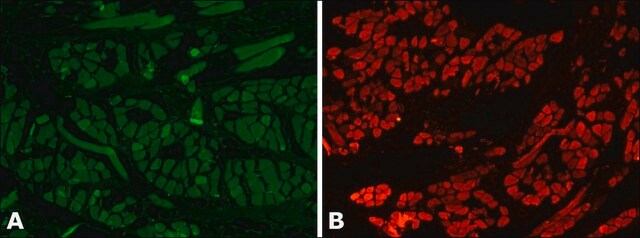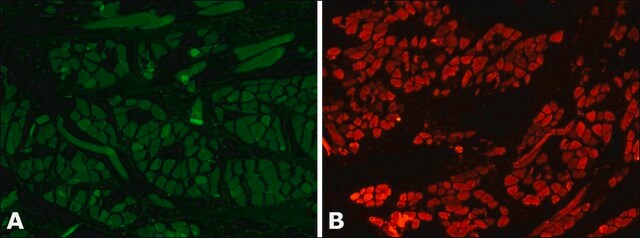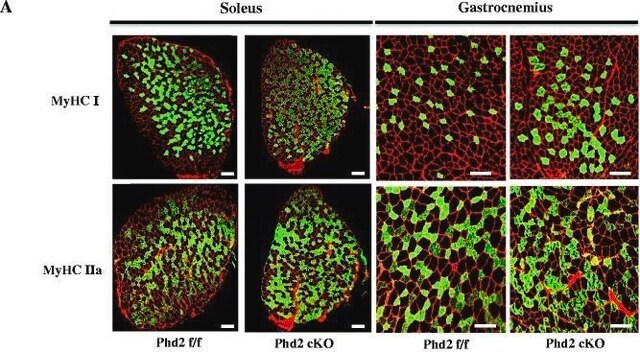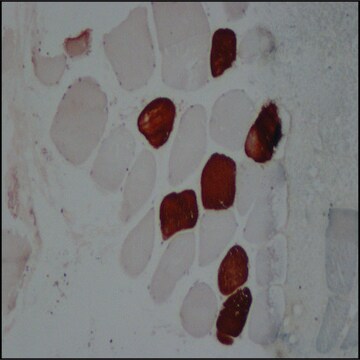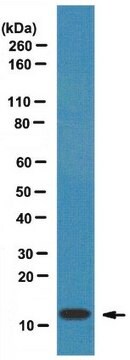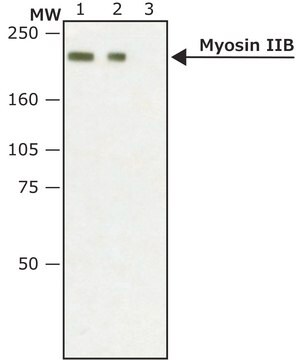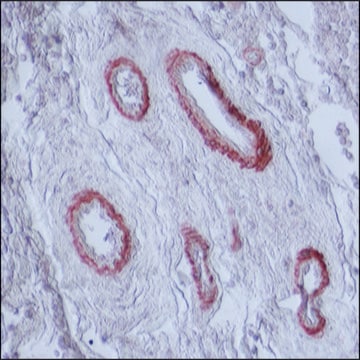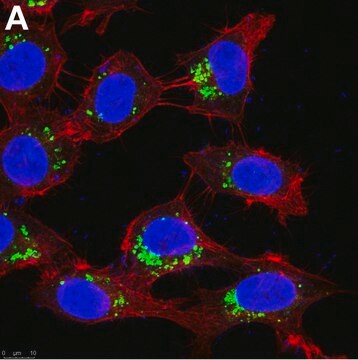M7648
Anti-Myosin (Skeletal and Smooth) antibody produced in rabbit
whole antiserum
Iniciar sesiónpara Ver la Fijación de precios por contrato y de la organización
About This Item
Productos recomendados
origen biológico
rabbit
conjugado
unconjugated
forma del anticuerpo
whole antiserum
tipo de anticuerpo
primary antibodies
clon
polyclonal
contiene
15 mM sodium azide
reactividad de especies
animal, human
técnicas
indirect immunofluorescence: 1:10 using cultured fibroblasts
Condiciones de envío
dry ice
temp. de almacenamiento
−20°C
modificación del objetivo postraduccional
unmodified
Información sobre el gen
human ... MYH10(4628) , MYH9(4627) , MYL9(10398)
Categorías relacionadas
Descripción general
Myosin is a 500 kD protein that interacts with actin in muscle and in non-muscle cells. It is characterized with two identical heavy chains (200 kD each) and four light chains (15-20 kD each). Myosin molecules consist of two major regions; the tail (rod) and head. These molecules aggregate into filaments through the tail region and interact with actin and ATP through the head region.
Especificidad
Shows a pattern of staining along stress fibers of cultured human and animal fibroblasts.
Inmunógeno
whole myosin (heavy and light chains) from bovine uterus.
Aplicación
Anti-Myosin (Skeletal and Smooth) antibody produced in rabbit has been used in indirect immunofluorescence labeling.
Acciones bioquímicas o fisiológicas
Myosin plays a vital role in neurosensory and cortical function, membrane vesicle trafficking and determinant partitioning. Myosins with actin-stimulated ATPase activity is essential for various cellular movements. Myosins I and V mediates vesicle translocation. Myosin II with a long rod like tail domain, assembles into a bipolar thick filament and facilitate muscle contraction.
Cláusula de descargo de responsabilidad
Unless otherwise stated in our catalog or other company documentation accompanying the product(s), our products are intended for research use only and are not to be used for any other purpose, which includes but is not limited to, unauthorized commercial uses, in vitro diagnostic uses, ex vivo or in vivo therapeutic uses or any type of consumption or application to humans or animals.
¿No encuentra el producto adecuado?
Pruebe nuestro Herramienta de selección de productos.
Código de clase de almacenamiento
12 - Non Combustible Liquids
Clase de riesgo para el agua (WGK)
nwg
Punto de inflamabilidad (°F)
Not applicable
Punto de inflamabilidad (°C)
Not applicable
Elija entre una de las versiones más recientes:
¿Ya tiene este producto?
Encuentre la documentación para los productos que ha comprado recientemente en la Biblioteca de documentos.
Anke Oertel et al.
Cell biology international, 27(12), 977-986 (2003-12-04)
Myosin was detected on Western blots of Micrasterias denticulata extracts by use of antibodies from different sources. Inhibitors with different targets of the actomyosin system, such as the myosin ATPase-blockers N-ethylmaleimide (NEM) and 2,3-butanedione monoxime (BDM), or the myosin light
Jenny Krönström et al.
Cell and tissue research, 336(2), 299-308 (2009-04-03)
Inside the light organs of the bioluminescent (light-producing) crustacean Meganyctiphanes norvegica (krill), numerous capillaries drain haemolymph into the light-producing structure (lantern). We have investigated the arrangement and function of filamentous material found around the opening of the capillaries. These have
Root hair formation: F-actin-dependent tip growth is initiated by local assembly of profilin-supported F-actin meshworks accumulated within expansin-enriched bulges
Baluska F, et al.
Developmental Biology, 227(2), 618-632 (2000)
Myosin: The Actin Motor Protein
Molecular Cell Biology, 10(1), 80-86 (2000)
Torsten Wollert et al.
The Journal of cell biology, 159(4), 571-577 (2002-11-20)
It is widely believed that microtubule- and F-actin-based transport of cytoplasmic organelles and membrane fusion is down-regulated during mitosis. Here we show that during the transition of Xenopus egg extracts from interphase to metaphase myosin V-driven movement of small globular
Nuestro equipo de científicos tiene experiencia en todas las áreas de investigación: Ciencias de la vida, Ciencia de los materiales, Síntesis química, Cromatografía, Analítica y muchas otras.
Póngase en contacto con el Servicio técnico